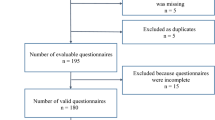Abstract
Goals of work
The aim of the study is to determine the predictors for seeking a second opinion and the utilization of complementary and alternative medicine (CAM) among gynecologic cancer patients.
Patients and methods
Patients attending a gynecologic cancer clinic of a tertiary referral center were recruited over a period of 1 year. A survey was conducted for all the participants in a one-on-one basis.
Main results
One hundred ninety-one patients were recruited. Eighty patients (41.9%) had consulted other health-care professionals (HCP) for a second opinion after they were diagnosed to have cancer and 89 (46.6%) had utilized CAM. In multivariate analysis, late-stage disease (OR=2.65, 95% CI 1.26–5.58), treatment with radiotherapy (OR=2.27, 95% CI 1.19–4.33) and tertiary education (OR=11.28, 95% CI 3.06–41.54) were independent predictors for seeking a second opinion from other HCP and utilization of CAM. Patients who sought a second opinion from other HCP were more likely to utilize CAM (OR=6.12, 95% CI 3.24–11.54). Eighty percent of the patients did not inform their usual caregiver their utilization of CAM.
Conclusions
Seeking a second opinion from other HCP is common in gynecologic cancer patients. Patients who seek a second opinion are more likely to utilize CAM.
Similar content being viewed by others
References
Astin JA (1998) Why patients use alternative medicine: results of a national study. JAMA 279:1548–1553
Cassileth BR (1999) Complementary and alternative cancer medicine. J Clin Oncol 17:44–52
Cassileth BR, Schraub S, Robinson E, Vickers A (2001) Alternative medicine use worldwide: the international union against cancer survey. Cancer 91:1390–1393
Cui Y, Shu XO, Gao Y, Wen W, Ruan ZX, Jin F, Zheng W (2004) Use of complementary and alternative medicine by Chinese women with breast cancer. Breast Cancer Res Treat 85(3):263–270
DiGianni LM, Garber JE, Winer EP (2002) Complementary and alternative medicine use among women with breast cancer. J Clin Oncol 20:34S–38S
Ernst E (2002) Toxic heavy metals and undeclared drugs in Asian herbal medicine. Trends Pharmacol Sci 23:136–139
Ernst E, Cassileth BR (1998) The prevalence of complementary/alternative medicine in cancer: a systematic review. Cancer 83:77–82
Fernandez C, Pyesmany A, Stutzer C (1999) Alternative therapies in childhood cancer. N Engl J Med 340:569–570
Fujita K (2004) Food–drug interactions via human cytochrome P450 3A (CYP3A). Drug Metab Drug Interac 20(4):195–217
Lee GB, Charn TC, Chew ZH, Ng TP (2004) Complementary and alternative medicine use in patients with chronic diseases in primary care is associated with perceived quality of care and cultural beliefs. Fam Pract 21(6):654–660
Lewith GT, Breen A, Filshie J, Fisher P, McIntyre M, Mathie RT, Peters D (2003) Complementary medicine: evidence base, competence to practice and regulation. Clin Med 3(3):235–240. review
Markman M (2002) Safety issues in using complementary and alternative medicine. J Clin Oncol 20:39S–41S
McCarthy EG, Finkel ML (1981) Second consultant opinion for elective orthopedic surgery. Am J Public Health 71:1233–1236
McCarthy EG, Finkel ML, Ruchlin HS (1981) Second opinions on elective surgery. The Cornell/New York Hospital study. Lancet 1:1352–1354
Navo MA, Phan J, Vaughan C, Palmer JL, Michaud L, Jones KL, Bodurka DC, Basen-Engquist K, Hortobagyi GN, Kavanagh JJ, Smith JA (2004) An assessment of the utilization of complementary and alternative medication in women with gynecologic or breast malignancies. J Clin Oncol 22:671–677
Sato T, Takeichi M, Hara T, Koizumi S (1999) Second opinion behaviour among Japanese primary care patients. Br J Gen Pract 49:546–550
Sato T, Takeichi M, Shirahama M et al (1995) Doctor-shopping patients and users of alternative medicine among primary care patients. Gen Hosp Psych 17:115–125
Shannon M (1999) Alternative medicines toxicology: a review of selected agents. J Toxicol Clin Toxicol 37:709–713
Sutherland LR, Verhoef MF (1994) Why do patients seek a second opinion or alternative medicine? J Clin Gastroenterol 19:194–197
Swisher EM, Cohn DE, Goff BA et al (2002) Use of complementary and alternative medicine among women with gynecologic cancers. Gynecol Oncol 84:363–367
Tang JL, Leung PC (2001) An efficacy-driven approach to the research and development of traditional Chinese medicine. Hong Kong Med J 7(4):375–380
Tasaki K, Maskarinec G, Shumay DM, Tatsumura Y, Kakai H (2002) Communication between physicians and cancer patients about complementary and alternative medicine: exploring patients’ perspectives. Psycho-oncology 11:212–220
Von Gruenigen VE, White LJ, Kirven MS et al (2001) A comparison of complementary and alternative medicine by gynecology and gynecologic oncology patients. Int J Gynecol Cancer 11:205–209
Wai WT, Lan WS, Donnan SP (1995) Prevalence and determinants of the use of traditional Chinese medicine in Hong Kong. Asia Pac J Public Health 8:167–170
Wang DIC, Leung JC, Wi OC, Gao N (1997) Biotechology and Hong Kong. In: Berger S, Lester R (eds) Made in Hong Kong. Oxford University Press, Hong Kong, pp 249
Wong TW, Yu TS, Lui JL, Lee NL, Lloyd OL (1997) Factors associated with the utilization of traditional Chinese medicine in a small town in Hong Kong. Am J Chin Med 25:367–373
Yates KM, O’Connor A, Horsley CA (2000) “Herbal ecstasy”: a case series of adverse reactions. N Z Med J 113:315–317
Acknowledgements
This work was supported by the Committee on Research and Conference Grant Council, University of Hong Kong, Hong Kong (10202159/18323/20900/323/01).
Author information
Authors and Affiliations
Corresponding author
Rights and permissions
About this article
Cite this article
Tam, K.F., Cheng, D.K.L., Ng, T.Y. et al. The behaviors of seeking a second opinion from other health-care professionals and the utilization of complementary and alternative medicine in gynecologic cancer patients. Support Care Cancer 13, 679–684 (2005). https://doi.org/10.1007/s00520-005-0841-4
Received:
Accepted:
Published:
Issue Date:
DOI: https://doi.org/10.1007/s00520-005-0841-4




